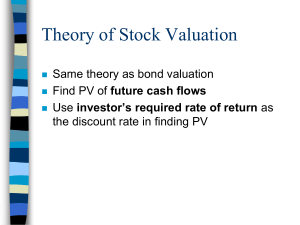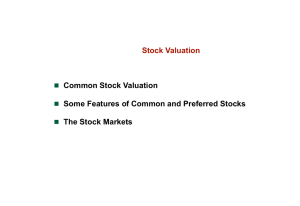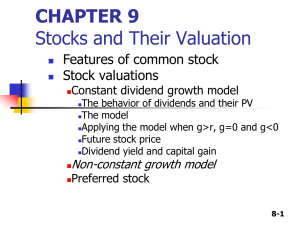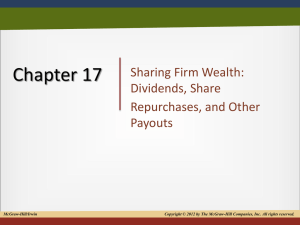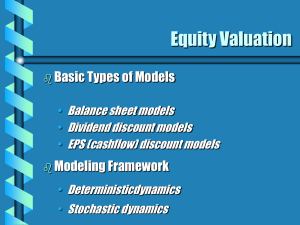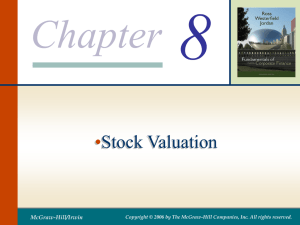Why do firms pay dividends? International evidence on the
advertisement
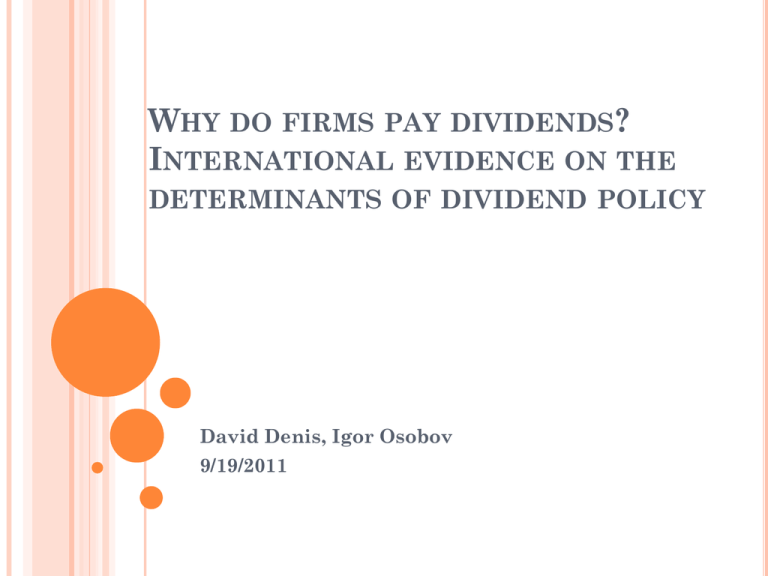
WHY DO FIRMS PAY DIVIDENDS? INTERNATIONAL EVIDENCE ON THE DETERMINANTS OF DIVIDEND POLICY David Denis, Igor Osobov 9/19/2011 OUTLINE I. Background: Existing theories for dividend policy II. Sample selection a data description III. Determinants of the propensity to pay dividends IV. Changes in the propensity to pay dividends V. Concentration of dividends and earnings VI. Catering incentives & Propensity to pay dividends VII. Conclusions 2 I. BACKGROUND: WHY DO FIRMS PAY DIVIDENDS? Existing 1. 2. 3. 4. Theories: Signaling Clientele Catering the investors Lifecycle 3 SIGNALING THEORY Due to information asymmetry, investors look for information that may provide a clue as to the firm's future prospects Dividend announcements convey information to investors regarding the firm's future prospects 4 CLIENTELE THEORY Firms set dividend policy to satisfy the demand for payouts from heterogeneous dividend clienteles Similar idea as “product differentiation” in economics The set of assets available to investors allows them to build sufficiently welldiversified portfolios with the desired dividend level and risk characteristics 5 CATERING THEORY Investors may have preference for dividend payers (dividend premium) Firms pay dividends when investors have dividend premium, not paying when there is no such premium 6 LIFE-CYCLE THEORY Driven by the need to distribute the firm’s free cash flow, in order to control agency cost Trade-off between the flotation cost savings and the agency costs of cash retention Firms optimally alter dividends through time in response to the evolution of their opportunity set. 7 II. SAMPLE SELECTION A DATA DESCRIPTION Worldscope data All firms with information on total asset, common equity, net income, interest expense; Nonmissing information for common dividends, method of reporting long-term investments having interest in excess of 50% Exclude utilities, financial firms and firms with negative book equity Over the time period of 1989~2002 9 III. DETERMINANTS OF THE PROPENSITY TO PAY DIVIDENDS Explanatory variables: Size (percent of firms with smaller market capitalization) Growth opportunities (Vt/At), Change in total asset (dAt/At), Profitability (Et/At) Earned/contributed equity mix (REt/BEt), proxy for lifecycle stage 10 Table 1 Characteristics of payers and nonpayers 11 Table 2 The proportion of payers as a function of earned and total equity 12 III. DETERMINANTS OF THE PROPENSITY TO PAY DIVIDENDS To quantify the marginal effects of the explanatory variables in explaining dividend payout decisions, run logit regressions (multivariate analysis) 13 Table 4 Logit regressions to explain dividend payout decision 14 III. DETERMINANTS OF THE PROPENSITY TO PAY DIVIDENDS Conclusion 1 Determinants are similar across countries: larger size, greater profitability, greater earned/contributed equity make the firms more likely to pay dividends; the effect of growth opportunities is ambiguous 15 IV. CHANGES IN THE PROPENSITY TO PAY DIVIDENDS How to measure the propensity? Baseline estimate: run regression using data of the period 1989-1993 (base period), then calculate the probability of dividend payments for each firm in subsequent years based on their characteristics in that year Changes in the propensity to pay dividends (changes in the unexpected proportion of payers) can be measured as the difference between the expected and the actual proportion of payers 18 Table 5 Out-of-sample estimates from logit regressions of the percent of firms paying dividends 19 Table 6 Unexpected reductions in the propensity to pay dividends in 2002 by retained earnings/total equity (RE/BE) 20 IV. CHANGES IN THE PROPENSITY TO PAY DIVIDENDS If there are reductions in the propensity to pay dividends, they appear to be concentrated among those firms most likely to be at the margin for paying dividends Can the reduction happen just because of Wordscope coverage biases? 21 IV. CHANGES IN THE PROPENSITY TO PAY DIVIDENDS What is the primary cause for the shortfalls? Abandonment by existing payers OR Unexpected failure to initiate by newly listed firms No material chagnes in the dividend policies of firms that were listed prior to 1993 Table 8 Dividend abandonment versus failure to initiate 24 V. CONCENTRATION OF DIVIDENDS AND EARNINGS Propensity to pay dividends declined (in the US), but the aggregate real dividends increase Strong correlation exists between the concentration of dividends and concentration of earnings and market capitalization 25 Table 9 Aggregate real and nominal dividend payments 26 Table 10 The concentration of dividends, market capitalization and earnings 27 V. CONCENTRATION OF DIVIDENDS AND EARNINGS Dividend signaling and clientele consideration cannot be first-order determinants of dividend policies 28 SIGNALING Not supported by data Firms with low earned/contributed equity seem more likely for dividend signaling, but these are the ones that do not pay dividends In recent years, dividends are becoming more concentrated among the largest, most profitable payers 29 CLIENTELE Not supported by data Dividend payers account for more than 90% of the aggregate market capitalization in most countries Top 20% of dividend payers account for virtually all of the market capitalization of dividend payers => not diverse enough so satisfy investor demand 30 WHY DO FIRMS PAY DIVIDENDS? Existing 1. 2. 3. 4. Theories: Signaling Clientele Catering the investors Agency cost-based lifecycle 31 VI. CATERING INCENTIVES IN EXPLAINED THE PROPENSITY TO PAY DIVIDENDS If catering theory is important in explaining the propensity to pay dividends, then (a). The percentage of unexpected dividend payers should be highly correlated to dividend premium (b). Dividend “switchers” would start and stop paying dividends in response to the market’s dividend premium Dividend premium is defined as the difference between the log of the weighted-average market-to-book ratio of payers and that of nonpayers 32 Table 11 Dividend premiums and the unexpected proportion of dividend payers 33 VI. CATERING INCENTIVES IN EXPLAINED THE PROPENSITY TO PAY DIVIDENDS (a). The percentage of unexpected dividend payers is correlated to dividend premium? NO! (b). Do dividend “switchers” start and stop paying dividends in response to the market’s dividend premium? 34 Table 12 Dividend premiums and the frequency of initiations and omissions by dividend switchers 35 VI. CATERING INCENTIVES IN EXPLAINED THE PROPENSITY TO PAY DIVIDENDS (a). The percentage of unexpected dividend payers is correlated to dividend premium? NO! (b). Do dividend “switchers” start and stop paying dividends in response to the market’s dividend premium? NO! 36 WHY DO FIRMS PAY DIVIDENDS? Existing 1. 2. 3. 4. Theories: Signaling Clientele Catering the investors Agency cost-based lifecycle 37 VII. MAIN CONCLUSIONS 1. Larger, more profitable, greater retained earnings/total equity ratio=> propensity to pay dividends (the effect of growth opportunities is ambiguous) 2. In the period of 1994~2002, there is a reduction in the propensity to pay dividends (though the propensity declines are fairly small and not always robust), driven by a failure of newly listed firms to initiate dividends when expected to 3. Aggregate dividends not declined, and concentrated among largest, most profitable firm 38 SUMMARY Main Contribution: The first to provide international evidence on the importance of the earned/contributed equity mix in dividend policies Potential Future Research Area: Why newly listed firms are less likely to initiate dividends in recent years? Whether characteristics that are not considered in the regression model caused this? 39

